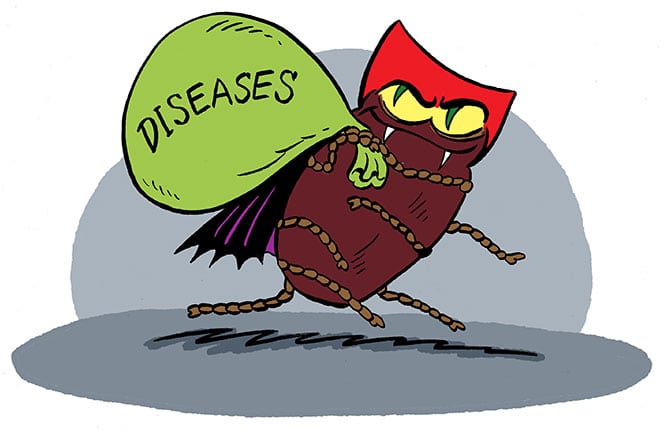The best way to avoid long-term consequences of Lyme and tick-borne illnesses is to prevent tick bites altogether. Use the following tips to minimize your exposure to disease-carrying ticks:
- Avoid tick-infested areas when possible. When walking in the woods, stay in the center of trails, avoiding contact with overhanging grass and brush. Trails are less attractive areas for ticks to live than dense underbrush.
- Wear light-colored clothing, long sleeves and pants, and tuck pants into socks. Wear a hat and tie back long hair to make it harder for ticks to attach to your scalp.
- When walking or working in the woods for an extended period, use duct tape wrapped inside out around the ankles to trap ticks attempting to crawl up your legs.
- Wear EPA-approved repellents appropriate for adults or children. Carefully follow the manufacturer’s instructions for application; some repellents are designed for application to clothes and equipment only. For more information, see the EPA Insect Repellent, Use and Effectiveness website: http://cfpub.epa.gov/oppref/insect/
- When coming in from outside activities where ticks may exist, put clothes in the dryer set on high heat for at least 30 minutes. Ticks cannot survive the dry heat. They can survive exposure to hot water, so skip the washing machine and expose the clothing to the high heat of the dryer first.
- After spending time outdoors where you might have been exposed to ticks, make sure you get undressed in a dry bathtub so you can spot ticks that fall off clothing. Immediately shower using a washcloth to knock off any unattached ticks and DO A ROUTINE TICK CHECK on yourself and your children.
- Check dark, moist areas, hair and scalp, behind ears and knees, elbows, underarms, skin folds and the groin area. Though it may take time to include a tick check into your family routine, over time it can become as simple as daily tooth brushing.
A few things to remember:
- Daily full-body tick checks of yourself and all family members are your first and most important prevention against Lyme and tick-borne diseases.
- If you are diligent about checking for ticks, there is no need to limit or abandon your usual outdoor activities.
- Other possible tick-borne co-infections found in your area could include Bartonella, Babesia, Rocky Mountain Spotted Fever, Ehrlichia, and Tularemia. See our “Co-infections” section for more information about these diseases.
- Young children have a higher incidence of Lyme disease than adults – possibly due to spending more time outdoors.
- If you have ever had Lyme disease, you are not immune and may contract the disease again upon re-exposure.
For more information about preventing tick bites, please see the Centers for Disease Control and Prevention website: http://www.cdc.gov/lyme/
- CDC – Preventing Tick Bites on People, Pets & In the Yard
http://www.cdc.gov/lyme/prev/index.html
Learn more:
- Tick Encounter Resource Center
http://www.tickencounter.org/ - Prevention, Ticks, Disease Ecology, Cary Institute
http://www.caryinstitute.org/science-program/our-scientists/dr-richard-s-ostfeld - EPA Insect Repellent: Use and Effectiveness
http://cfpub.epa.gov/oppref/insect/ - Insect Repellents
http://www.wildlife.state.nh.us/Wildlife/Wildlife_PDFs/Insect_Repellents_CoopExt_Feb09.pdf
This link stated oil of lemon eucalyptus should NOT be used on children younger than 3 years old. - Tick Taxonomy
http://bioweb.uwlax.edu/bio203/s2008/clarin_bria/Classification.htm
Insect Shield Products
Using insect shield products and clothing can protect tick bites. Here are some links with recommendations on how to create your own insect shield clothing, as well as insect shield clothing and products.
- “Insect Shield your own Clothes”
http://www.tickencounter.org/prevention/insect_shield_your_own_clothes - Insect Shield Clothing
http://www.insectshield.com/default.aspx - Insect Shield Chair
http://shop.vtarmynavy.com/insect-shield-chairp9532.aspx?utm_medium=cse&utm_source=googlebase&gclid=CPPdyLmM0rwCFelxOgodNB0ALQ




